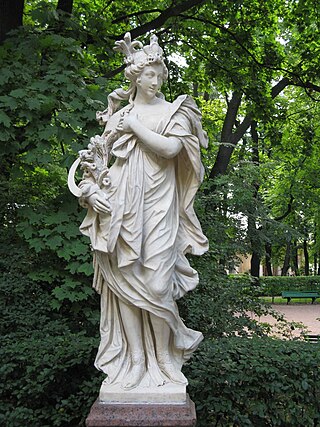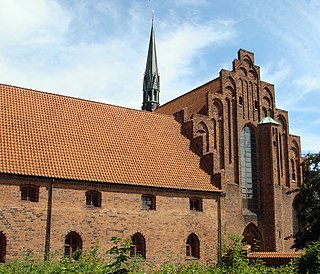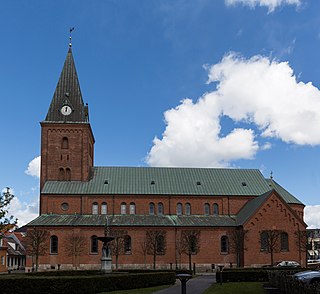
St. Canute's Cathedral, also known as Odense Cathedral, is named after the Danish king Canute the Saint, otherwise Canute IV. It is a fine example of Brick Gothic architecture. The church's most visited section is the crypt where the remains of Canute and his brother Benedict are on display.

Thomas Quellinus, also known, especially in Denmark, as Thomas Qvellinus, was a Flemish baroque sculptor. He was born in Antwerp as a member of the well-known Quellinus family of artists active in 17th century Antwerp. He worked most of his career in Copenhagen, Denmark, where he operated a workshop. He is especially known for the production of grandiose and sumptuous memorial chapels, sepulchral monuments and epitaphs, which can be found in churches throughout Denmark and northern Germany's Schleswig-Holstein area. His chapels and monuments are dramatically composed, executed in rare, differently coloured types of marble and framed by monumental architectural components.

The Hospital of the Holy Ghost, Aalborg, the buildings of which, although now without any religious function, are still known as Aalborg Kloster, is a former establishment of the Order of the Holy Ghost in Aalborg, Denmark. It was the hospital of Aalborg from 1431 to 1953 and is one of Denmark's best preserved medieval establishments. These are the oldest buildings in north Jutland, and the former hospital is also the oldest social institution in Denmark.

The Church of Our Lady is the Lutheran cathedral of Copenhagen. It is situated on the Frue Plads public square in central Copenhagen, next to the historic main building of the University of Copenhagen.

The Church of Our Lady is one of the larger church structures of Århus, Denmark. It is situated in the centre of the city not far from Aarhus Cathedral. The church and associated structures were built in several stages in the course of the Middle Ages, from the late 1200s to 1500 AD. The original church at the site, stood finished as early as 1060 AD, but only the stone crypt remains today as evidence of its existence.

Budolfi Church is the cathedral church for the Lutheran Diocese of Aalborg in north Jutland, Denmark.

Roskilde Abbey or Our Lady's Abbey, Roskilde, was a nunnery dedicated to Saint Mary the Virgin. The abbey was located at Roskilde on the Danish island of Zealand. It was founded in the early 12th century for Benedictine nuns, but in 1177 became part of the Cistercian reform movement. The abbey was suppressed in 1536 during the Protestant Reformation in Denmark. It is now the site the Old Church of Our Lady, Roskilde .

The Carmelite Priory, Helsingør, or Priory of Our Lady, Helsingør, was a house of Carmelite friars in Helsingør, Zealand, Denmark, established in 1430. It is the finest example of a complete monastic complex surviving in Denmark, and one of the best in all of Scandinavia.

The Diocese of Aarhus is one of 10 dioceses in the Church of Denmark, with headquarters in the city of Aarhus. The diocese covers a large district of northeast Jutland and comprises 14 deaneries, of which four cover the extent of Aarhus city itself.
Svendborg Friary was a Franciscan friary in Svendborg, on the island of Funen, in the present Region of Southern Denmark, and was one of the earliest Franciscan foundations in Denmark. Like almost all Danish religious houses it was dissolved during the Protestant Reformation of the 16th century.
Tvilum Priory was a monastery of Augustinian Canons at Tvilum near Gjern, to the north of Silkeborg, Denmark.

Ringsted Abbey was one of the earliest and most influential Benedictine houses in Denmark, active from the late 11th-century until the Danish Reformation. It was located at Ringsted on the Danish island of Zealand.

Æbelholt Abbey was an Augustinian monastery situated at Tjæreby in Hillerød municipality in North Zealand, Denmark.

The Abbey of Our Lady, Aalborg was an early Benedictine monastery in Aalborg, Denmark. The former monastic church survived a parish church until 1876 when it was demolished. The present Vor Frue Kirke was built on the site between 1877 and 1878.

St. Catherine's Priory was an important early Dominican friary, located in Ribe, Denmark from 1228 until 1536. The buildings still stand, although there is no monastic community there. Known as Ribe Kloster, it is Denmark's most complete extant monastic building complex.

Veng Abbey was one of Denmark's earliest Benedictine monasteries. It was located in the village of Veng near Skanderborg, Region of Southern Denmark. Veng Church, the former abbey church, is still in use as a parish church and is the oldest remaining in the country.

The Church of Our Lady in Assens is located on (Fyn). It is a Church of Denmark parish church.

The Old Church of Our Lady is an 11th-century brick church in Roskilde on the Danish island of Zealand.

Klostergade is a street in Aarhus which runs east from Grønnegade to Studsgade, intersecting a number of streets.

Catholic Church of Our Lady is a church in Aarhus, Denmark. The church is situated in the central Indre By neighbourhood on the pedestrian street Ryesgade, close to the Central Station and City Hall. It is a Catholic Church within the Diocese of Copenhagen; built between 1877 and 1880 by designs of the German architect Franz Schmitz and later renovated by the architect Carl R. Frederiksen. The church has seating for 500 people.





















